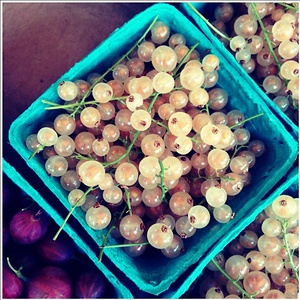


White Currant Berries
Estimated Inventory, 12 ct : 0
Description/Taste
White currants are small, round berries resembling green grapes in appearance. Each berry measures approximately 0.5 to 1 centimeter in diameter and grows in delicate strands on woody shrubs, which can reach up to two meters in height. Initially green, White currants mature into creamy shades of pink and translucent white, the specific hue varying by variety. Their exterior is glossy and smooth to the touch. Inside, White currants possess a soft, pulpy flesh with a juicy texture, containing multiple small edible seeds. Although White currants retain a tanginess reminiscent of gooseberries, they are significantly sweeter than their black and red counterparts, boasting a floral aroma and complex flavors that include sour cherry, kiwi, muscat grape, and a lingering sweetness.
Seasons/Availability
White currants are available during the mid-summer months.
Current Facts
Often likened to white grapes, White currants are botanically categorized within the species Ribes rubrum, the same as red currants, and belong to the Grossulariaceae family, which includes gooseberries. While primarily used for culinary applications, White currants have potential medicinal benefits. The long, pearly vines they grow on also add ornamental value to gardens. White currants are easily damaged due to their extra thin skin and should be handled with extreme care. To harvest, the entire berry-laden twig should be snipped from the bush rather than the individual berries themselves. Native to Europe and parts of Asia, White currants are essentially an albino variant of red currants, displaying a range of colors from white to yellow and pink. Contrasting with the red and black currant varieties, which are often deemed too strong and tart for consumption in their fresh form, White currants offer a sweet and mild flavor profile.
Nutritional Value
White currants are an excellent source of vitamin C, an essential nutrient that protects the body against infections and supports skin and hair health. They also contain vitamin K, vital for bone health and the production of proteins necessary for blood clotting. White currants are a valuable source of dietary fiber, which aids in regulating your digestive system as well as blood sugar and cholesterol levels.
Applications
White currants can be enjoyed fresh, cooked, dried, or used as a garnish when coated with caster sugar. The top varieties of White currants for both raw and cooked applications include Blanka, White Grape, and Versailles Blanche. They retain a slightly tart flavor when cooked, which can be balanced by adding sugar or other sweeteners. The high pectin content in White currants makes them ideal for creating jams, jellies, or tart fillings, though it is recommended to sieve out the small seeds. For desserts, White currants can be suspended in gelatin or incorporated into frozen fruit juice popsicles. White currants enhance wines, marinades, sauces, cordials, and meat dishes. They pair well with cinnamon, nutmeg, vanilla, cream, clove, citrus fruits, tomatoes, juniper, ginger, strawberries, huckleberries, peaches, cherries, gin, basil, lemon verbena, and mint. To store, White currants can be refrigerated for up to a week or frozen for extended use.
Ethnic/Cultural Info
The Versailles currant, a variety of White currant, was developed in France in 1843. Its name is derived from the renowned Palace of Versailles, the former royal residence and administrative heart of France, located just outside Paris. Cultivated in the palace gardens, the Versailles Currant reflects the high horticultural standards practiced there during the reign of Louis XIV and subsequent French monarchs.
Geography/History
White currants are a natural mutation of red currants, with ancestral origins in Central and Eastern Europe and parts of Asia. They thrive in cool, temperate, and arid environments, ideally in areas with a winter chilling period. White currants favor full sun exposure but achieve optimal growth when protected from strong, hot winds. Known primarily as a domesticated fruit, White currants are most commonly found in gardens, farms, and horticultural settings rather than in the wild. They were used for their medicinal properties in the 15th century before being domesticated in Scandinavian countries during the 16th century. The trade and cultivation of White currants expanded to Western Europe in the 17th century and subsequently to other regions, including North America, by the 18th century. White currants are somewhat of a rarity but can be found in specialty stores and farmers' markets during their peak season. For those unable to find them fresh, Eastern European or Central Asian supermarkets may offer them in the frozen foods aisle. Additionally, large grocery stores might carry dried White currants and their jams.
Recipe Ideas
Recipes that include White Currant Berries. One
| Katie at the Kitchen Door |
|
Lavender and White Currant Muffins |
| Healthfully Ever After |
|
Summer White Currant Lemonade Cocktail |
| Jam Making |
|
White Currant Jam |















